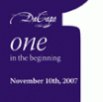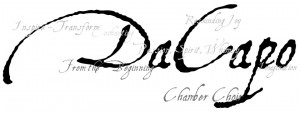
After my first DaCapo concert, there was no going back. From then on, I knew I’d never hear choir music in quite the same way again.
It’s not simply the music that artistic director Leonard Enns selects — which is potent and often supremely challenging.
Nor is it that the thoughtful use of a unifying motif for each concert is then reflected and refracted through carefully chosen overarching themes that, in turn, unify each season. It’s mainly because they’re among the best choirs I’ve ever heard.
Before hearing Da Capo, I enjoyed choir performances in a casual way. After, well, I would now go so far as to call myself an enthusiast of contemporary choir music. Such is the power of the sound they create.
Saturday’s performance at St. John the Evangelist Church in Kitchener certainly lived up to my expectations.
This concert featured the theme of One. The rest of the season will explore the motifs of Two and Three.
Everyone was still chatting and laughing when the subtle sense of an underlying thrum — a vibration that was experienced as much through the body as it was heard — rose and hung, suspended, in the air.
Slowly it emerged, growing gradually louder, until the even the liveliest of conversationalists couldn’t help but take notice.
The chatter subsided as the 20-person choir walked up the aisles of the church, the their voices floating around them with an almost magical tangibility. This was Calme, a choral improvisation by Leonard Enns. The choir assembled up front, but for a time, they kept their backs to us as they concentrated on the layers of sound they created.
Then, they turned around, opened their scores and the sound resolved itself into a tighter focus — an evocation of still nights and the love of quiet things, drawn from a poem by Camille Saint-Saëns.
Credo, by Finnish composer Einojuhani Rautavaara, came next. It featured two contrasting moods that ultimately created an interesting symmetry of sound. Beginning with an imperative sense of forward movement, the first mood featured layered musical lines and an energetic rhythm that enacted the inexorable power of the statements of belief made in the accompanying text.
The second mood, in which the text shifted to a contemplation of the life and death of Christ, became more enigmatic, subdued and transcendent — before the piece finished with a shift back to the original, driving potency of the credo.
Another interesting symmetry emerged through the performance of Aaron Copland’s In the Beginning during the first portion of the program, followed by Randall Thompson’s The Peaceable Kingdom in the second half. The Copland piece deals with creation, beauty and the emergence of life.
The multitude of the choral voices interacted with soloist Esther Farrell’s earthy mezzo-soprano, creating a sense of movement and unity between the one and the many.
The musical narrative ebbed and flowed alongside the textual narrative of the seven days of creation, ending with a glorious culmination of sound, celebrating the breath of life and the emergence of the living soul.
The Thompson piece, by contrast, deals with a time of reckoning — it is a song of ends and of tumultuous retribution. This, then, is the dissolution of the world — the turmoil and judgment that precedes an ultimate time of peace to come, once the beginning and middle are resolved, unified and completed, by the end.
So it was that the three were ultimately resolved into One — and so began Da Capo’s intriguing new season.



